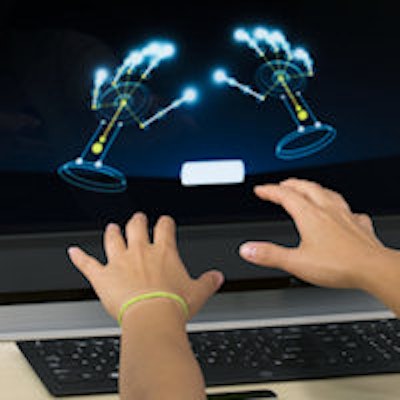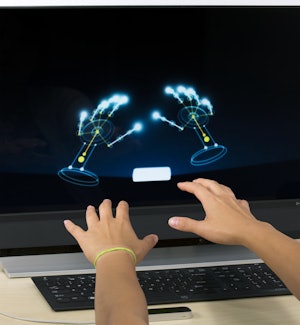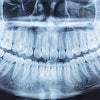
The modern dentist has access to a range of imaging tools that can aid in surgical procedures. Now, an experimental workstation could make existing diagnostic and surgical images even more user-friendly for oral surgery procedures with an important added benefit: The images can be manipulated without touching the display.
The workstation was presented in a recent study published in Imaging Science in Dentistry (June 11, 2014) and prepared and tested by Argentinean researchers from the CORE Dental Clinic in Resistencia and at the National University of the Northeast School of Dentistry Department of Pediatric Dentistry in Corrientes.
"The proposed system fulfilled the objective of providing touchless access and control of the system of images and a three-dimensional surgical plan, thus allowing the maintenance of sterile conditions," the researchers wrote. "This technology has enormous potential in dental surgery and other healthcare specialties."
Digital imagery is nearly fully integrated into dentistry, but the workstation can be an infection control issue. Touch pads and track balls can't be used without physical contact, an inherent flaw.
"The problem of cross-contamination and sterility is one of the greatest challenges in modern healthcare technology," the authors noted, a point highlighted by the downfall of several U.S. dentists tied to their poor infection-control practices. In regard to the health of the clinician, ergonomics also are important to dental professionals who desire longevity in their careers.
 An example of the Leap Motion controller sensing hand gestures. The device was used as an interface to manipulate images or navigate around digital imaging software in this study. Image courtesy of Leap Motion.
An example of the Leap Motion controller sensing hand gestures. The device was used as an interface to manipulate images or navigate around digital imaging software in this study. Image courtesy of Leap Motion.The touchless workstation employs natural user interfaces (NUIs), which enable a person to interact with a computer using normal human behaviors, such as hand gestures, by tracking them with motion-sensing hardware and recognition software. These gestures can be recognized in a given space, or "interaction zone." The setup utilized a motion-sensing input controller (Leap Motion), a device that is available to the general public for everything from surfing the Internet to video games, enabling the user to navigate around a screen with a swipe, pinch, wave, or grab. The low cost (about $79) also is an attractive quality, and it is likely the first time that this type of controller has ever been used during dental surgery.
The researchers incorporated Kodak dental imaging software and Carestream CS 3D imaging software v3.19 to work with 2D and 3D dental images. The software was used to manipulate a preliminary 3D model of the implant placement the surgeons were going to perform and to obtain new digital radiographic images during the surgery, the researchers explained. In addition, they incorporated a digital radiography system sensor (Kodak RVG5100, Carestream) to take intraoperative intraoral radiographic images.
With ergonomics and patient comfort in mind, the researchers had a modified dental chair built so that dentists could perform clinical and dental procedures while viewing two LCD monitors. Two surgeons performed simulated dental surgeries in the workstation's initial usability testing to calibrate the positioning of its components.
In the next phase, the researchers performed 11 dental surgery procedures, including multiple extractions of molars, incisors, and premolars; guided bone regeneration (GBR); dental implant placement (flap and flapless surgery); and provisional prostheses.
"Before and during the operations, the customized system was used for navigating through periapical radiographic images, panoramic radiographic images, and cone-beam computed tomography (CBCT) 2D images, and manipulating the preliminary 3D simulation model of the planned implant surgery and intraoperatory intraoral digital x-ray images," the researchers explained.
“It is easier and faster than changing sterile gloves or having an assistant outside the sterile environment.”
To pull up a cursor on the screen, the clinician pointed one or two fingers at the screen and navigated around different buttons or items on the screen; these could be selected with a "poking" motion. Other functions that necessitated two points of control, such as zoom, rotation, or modification of scale, could be accomplished with two fingers on one hand or one on each hand. The surgeon had the ability to make a variety of adjustments, such as image enhancements, contrast or brightness adjustments, and measurement, as well as moving and rotating 3D implant surgery planning models. Similarly, these manipulations could be applied to new x-rays.
Clinicians also used the system to confirm the positioning of surgical guides and the final position of implants.
"When simultaneous dental implant placement and GBR procedures were achieved, the new NUI system was used extensively and was very useful because the anatomy of the neighbor teeth and the maxillary sinus made the use of images imperative for correct implant placement while avoiding damage to anatomical structures," the researchers explained. It proved to be useful during the other procedures performed as well.
Aside from a single reboot, they encountered no technical failures. It was also user-friendly, with the researchers recommending four to six training sessions at 30 minutes each for clinicians who were previously familiar with the imaging software employed. "With a little training by the user, without a doubt, it is easier and faster than changing sterile gloves or having an assistant outside the sterile environment," they concluded.



















